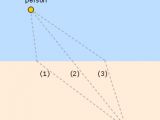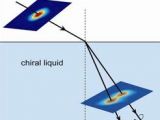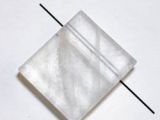Light comes into particles called photons. But photons don't just travel from place to place, they also spin around an axis. If you have a large number of photons coming from, say a light bulb, each of them usually spins around its axis with any orientation what-so-ever. Some materials however can absorb all the photons except some that spin around a certain axis. The light that has passed through such a filter is called polarized light.
This sounds much simpler than it actually is. In the same way as there exists a Heisenberg relation between momentum and position (which means that if you measure the position of something very precisely you change its momentum at random, making it unpredictable, and vice-versa when you measure the momentum), there also exists a Heisenberg relation between any two orthogonal axes of rotation.
Thus, the filter that is sensitive to a certain spin actually changes this spin because it randomly influences the rotation around the other two orthogonal axes. As a consequence, the polarized light that comes out of such a filter is not made exclusively from one type of photons (with a certain spin), but rather it is made of a bunch of photons that have a certain spin only statistically. Moreover, due to the same reason, it is impossible to actually determine which exact axis the filter is actually favoring (one can only make a statistic guess)!
If we have many photons we can treat them collectively as an electromagnetic wave and forget about their quantumness. This is similar to how we can speak about a sound wave although in reality we have a bunch of individual atoms of gas moving in a certain way. The story of the photons' spinning translates into the story of the plane in which this electromagnetic wave is oscillating.
You can imagine waving the jet of water coming from a hose. You can wave it in various planes - for example vertically or horizontally or in a circle. The waving jet is the analogous of the electromagnetic wave made from a constant supply of photons. The unpolarized light is equivalent to the situation when you wave the hose a random in all directions.
When such a wave encounters a polarizing filter however, the filter keeps only the "component" of the jet that waves in a certain plane. As mentioned, you cannot say much about the individual spins of the photons in this jet that emerges from the filter, or about the actual quantum mechanical "preferences" of the filter, but you can make this macroscopic assessment about the plane of polarization of the entire wave.
How the light waves move
Individual photons don't care very much about the laws of reflection or refraction. In fact they appear to be capable of moving on any path whatsoever. A large number of photons however form a wave that moves from A to B on the path that takes the least amount of time.
In case this wave travels through a material (be it a solid, a liquid or a gas) the photons interact with the molecules of the material. The outcome is that the speed of light, more precisely of the electromagnetic wave, in this material can be smaller than the speed in empty space (or in air or some other material).
The phenomenon of refraction is the consequence of the so-called lifeguard dilemma. Suppose you are David Hasselhoff or Pamela Anderson and you see someone in the water nearly drowning. You of course run to save his or her life. But which is the best path? You run fast of the ground but you swim much slowly, so the shortest path (2) isn't the best option. The path (3) is particularly stupid. The path that takes the shortest time is something like (1) and the exact point where you should enter water depends on the ratio between your speed on the ground and your speed in water.
Light waves appear to solve this problem better than any lifeguard and the consequence is the law of refraction. This law describes what happens when light passes from one medium to another. Of course, light has no foresight. It doesn't actually solve the lifeguard dilemma! But the statistical outcome of what individuals photons happen to do is this law.
Back to the issue of polarization
About two hundred years ago Augustin Fresnel, the one who demonstrated that light is a wave and stupefied his contemporaries with some unexpected experiments (such as the fact that the shadow of a small circular object has a light spot in the center), also understood the phenomenon of polarization. He studied so-called "optically active" materials - materials that change the polarization of the light that passes thought them. They could be both solids and liquids.
He realized that he could understand these materials by assuming that the speed of the wave in one direction is different from its speed in another orthogonal direction. This offered a simple explanation of how the optically active materials managed to change the polarization. The lack of velocity homogeneity introduces time lags in one direction relative to the other and changes the way the wave is oscillating. It's a nice explanation, but it is true?
Fresnel realized that is if were true that the optically active materials should split a linearly polarized beam of light (one that is oscillating in a single plane) in two beams of lights with a circular polarization (one rotating to the left and another to the right). The angle between the two diverging beams depends on the difference between the two speeds.
The phenomenon can be easily seen in solids - photo (credit: P. Fischer/Harvard Univ.). The two beams inside the crystal (such as calcite or quartz) are the result of the polarization splitting. But the effect is much harder to detect - and to understand - in liquids.
After about 200 years since Fresnel, Ambarish Ghosh and Peer Fischer from the Rowland Institute at Harvard University have now finally measured the effect in the case of liquids. Moreover, they did it using a technique proposed by Fresnel himself.
Because in case of optically active liquids the angle is very small, about ten-thousandth of a degree, Fresnel proposed amplifying the difference using a series of triangular prisms alternatively filled with two versions of the liquid. One version changes the polarization in one direction the other version in the other direction. Although Fresnel had no idea why the two versions of the same liquid acted as they did and what made them different he assumed that such a set-up would amplify the divergence between the two beams.
We now know what makes the two versions different and why they act like that on the polarization of light. Such optically active liquids are made of "chiral" molecules - molecules that have two different versions one the mirror image of the other one.
Ghosh and Fischer used a chiral liquid called limonene - a natural scented oil. By using Fresnel's set-up with the left-handed and right-handed forms of limonene, they clearly imaged the two separated beams with a high-resolution camera.
Besides testing for the first time an effect predicted 200 years ago, Ghosh and Fischer also created a new way of detecting the chirality of unknown substances. Until now, such an analysis has required a relatively large amount of liquid, but with the new technique a small cell, only a few hundred microns across is sufficient. By carefully measuring the refracted beam, researchers can accurately determine the relative proportion of the two molecular forms. This is very valuable for medical purposes where only small quantities of liquid are available.

 14 DAY TRIAL //
14 DAY TRIAL // 


